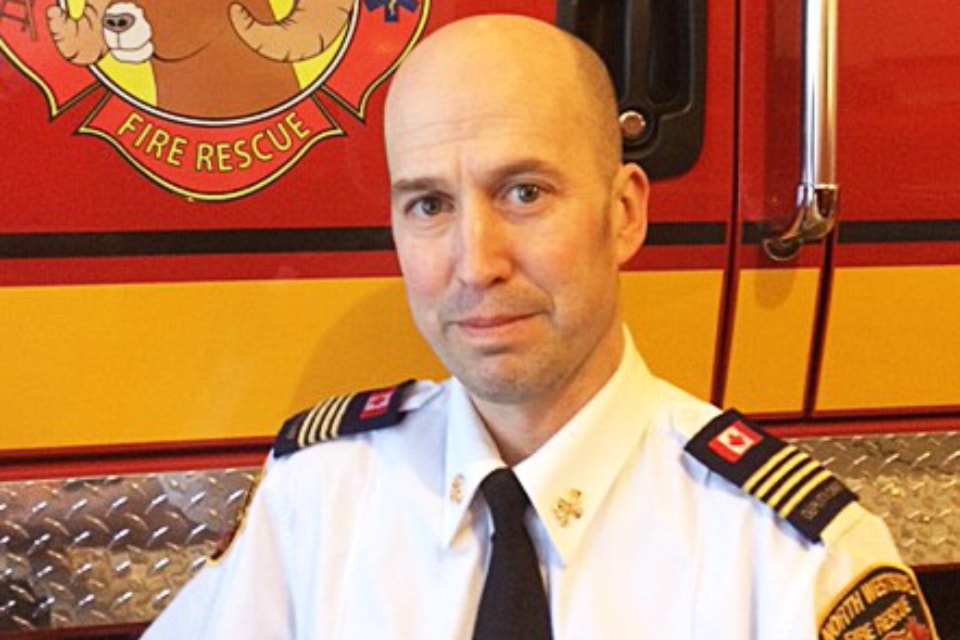A former North Westside Fire Rescue chief, who was suspended for withholding information and giving misleading information to the media before he was eventually fired, has lost his case with the BC Human Rights Tribunal, which dismissed his claim that the Regional District of Central Okanagan (RDCO) discriminated against him because of his post-traumatic stress disorder.
Jason Satterthwaite had argued his PTSD was among the reasons the RDCO and its former manager of fire services, Ross Kotscherofski, suspended and later terminated him, according to a recently published decision by the tribunal.
However, the tribunal found Satterthwaite provided "scant" evidence on how his PTSD was a factor in either the suspension or the termination.
According to the decision, Satterthwaite started his career with North Westside Fire Rescue as an on-call firefighter in 2006. He was promoted to fire chief of District B in 2015 and held that position until his suspension in May 2020. He was suspended because he'd withheld important information from the RDCO about its operations, had intentionally shared false and misleading information about district operations to the media, and had failed to discipline a firefighter who had also shared misleading information of the same sort to the media, the decision states.
It's unclear from the decision what Satterthwaite said to the media or how it was misleading, but Satterthwaite had a month before the suspension, along with Lieut. Rob Gajda to discuss concerns about being infected with COVID-19 on the job and bringing it back to their families in the early months of the pandemic. Their specific concern was that the RDCO had refused a member of the public's offer to provide an isolation house for firefighters to retreat to if infected, though the article goes on to say the regional district was still looking into the offer.
Satterthwaite's suspension caused an upheaval at the North Westside fire station. A month after the fact, the RDCO confirmed that several members of the fire department had walked off the job in protest of the suspensions of Satterthwaite and Gajda, the latter of whom was not involved in the human rights case. Little was known about either suspension at the time, but the RDCO said six paid-on-call firefighters handed in their pagers, and a seventh member submitted a notice of sick leave.
Under the suspension, Satterthwaite was prohibited from doing any fire chief or firefighter duties, attending training sessions or meetings, or going to the fire hall. He was informed he would remain suspended until he demonstrated a willingness to ÎÚÑ»´«Ã½œaccept and embrace the (RDCO's) managerial authority, to comply with policies and procedures, and to abide by the established chain of command."
Satterthwaite filed a complaint with WorkSafeBC against the district five days after the suspension, alleging he'd been suspended for raising an occupational health and safety concern. A decision on this complaint didn't come until January 2023, when WorkSafeBC found the decision to suspend him ÎÚÑ»´«Ã½œwas not in any way related to, or tainted by, the workerÎÚÑ»´«Ã½™s participation in protected activities, but was solely due to (his) conduct and poor judgment, particularly in his capacity as fire chief."
He'd filed another WorkSafeBC claim, saying his work as a firefighter for the regional district had left him with PTSD and reporting that since the suspension, he had been ÎÚÑ»´«Ã½œflooded with flashbacks of traumatic incidents he attended and (was) struggling with his emotions." WorkSafeBC accepted his claim for PTSD in August 2020.
Six months after he was suspended, Satterthwaite was first on the scene at a vehicle fire and stepped in to help, thereby breaching the terms of his suspension. He was swiftly fired.
The decision includes details about a 2019 bullying and harassment complaint Satterthwaite had filed with WorkSafeBC. He said he'd had a "challenging" time with regional district management over the two previous years and while the investigation was underway, he'd felt "intimidated." He also said two other firefighters had been falsely accused of something, there were unresolved tensions, and he was feeling a huge amount of stress.
Satterthwaite argued that his PTSD was connected to his suspension and termination. He described calling a crisis line after a kayak trip, which caused flashbacks to a 2018 incident where he was unable to save a person who had drowned in that same water.
However, the tribunal didn't agree with his claim that his PTSD was a factor in his dismissal, and in turn dismissed his case.
"There is no evidence before me that suggests Mr. Satterthwaite had PTSD or another mental disability until August 2020. There is similarly no evidence on which the Tribunal could find Mr. SatterthwaiteÎÚÑ»´«Ã½™s eventual PTSD was a factor that led to his suspension," the decision by tribunal member Laila Said Alam states. "Mr. SatterthwaiteÎÚÑ»´«Ã½™s evidence is that his PTSD symptoms emerged after his suspension. Mr. Satterthwaite has not explained how or if his PTSD contributed to his comments to the media and other firefighters about the districtÎÚÑ»´«Ã½™s operations.
"There is no reasonable prospect Mr. Satterthwaite will prove the conduct that resulted in his suspension was connected to his PTSD. I dismiss the allegation that his suspension was discriminatory."

